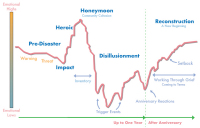
Eight months ago, in this Profit on Purpose article, I shared the model from Zunin and Myers (1992) that I’d been using in my CEO sessions to help contextualise why we had seen energy levels wax so strongly, then wane so dramatically over time, in response to the first lockdown.
Revisiting that model, we can also see why, as we go through three combined “trigger events”: the darkest and coldest part of winter, a third lockdown, and the approach of the anniversary of the initial crisis, energy levels are likely to be at their lowest ebb around now.
In normal times there’s a simple recipe for galvanising a team, raising both its energy and performance. Although to be fair, it’s easier to describe than it is to deliver.
The timeless ingredients are: a single big challenge rooted in the higher purpose of the organisation; wide boundaries of empowerment that give freedom and autonomy for those working on the challenge; and a culture and structures that foster and inspire deep trust and intense collaboration across the group. Simple, in theory.
The difficulty for leaders right now though, is how to land that “big challenge” model into an environment where people are already under chronic pressure. As one CEO put it, “We’ve no shortage of big challenges; I just don’t think the team has the energy right now to take them on.”
Many teams are struggling to deliver the day job, let alone something new and shiny; and they’re exceptionally tired – burnout is a real and present danger all round. So how do we break the energy barrier without burning out?
The solution to the first half of that problem is simply to recognise that the big challenge need not be something new. Want to galvanise a team around the day job? Find a way to craft that into a big, single-focus challenge.
The second half though, needs us to think much more holistically, about where energy comes from, and what the main factors are that contribute to burnout.
The psychologist, Dr Mike Drayton, picks this apart in his upcoming book Anti-Burnout, where he talks about three major factors: individual psychology, the structure of work, and the surrounding culture of the organisation.
I’ve written and spoken before about how we each have different ways to regain energy, largely due to our unique combination of personality traits – introvert, extrovert, reactive, organised, conventional, creative, and so forth. But the broader point is this: we’ve each had nine months to learn how we personally lose and gain energy, and drawing on this experience is now crucial. Reflection, self-awareness and self-care are the key steps to building much greater resilience across our teams over the coming months, and those are steps anyone can take at any time.
On the other two aspects of work structures and culture, the key as with so many of these things, is listening, learning, and facilitating the individuals in your organisation, to first understand, and then to implement the changes they need to adopt, in order to individually and collectively thrive.
This is invariably about support, empowerment and flexibility, within an overall structure that can hold teams together, increase collaboration and build shared understanding and trust.
For some of us, these might all still feel like worryingly fluffy concepts. We might be especially concerned that giving teams and individuals this much control over what they do and how they work, will inevitably lead to chaos, and a rapid breakdown of the order and control that any organisation needs to perform.
But nothing could be further from the truth, as long as your people are clear on and committed to the outcomes they need to collectively create, these are methodical, organised steps that will open up the conversation about how they can better achieve those outcomes while improving their own wellbeing. And they will help you build a more open, flexible and energising environment, within which team and individual performance will dramatically improve. This is a win-win for everyone involved.
I’m convinced that breaking the energy barrier without burning out will remain a critical top-level issue for many months to come as we work our way out of the pandemic and its penumbra. And so, I’ve asked Mike to join me for my evening seminar in March, for an open conversation and Q&A about energy and burnout, and how to improve psychological health and performance in the workplace.
You can find a recording of the session in our Past Event Recordings or watch it on YouTube here.
